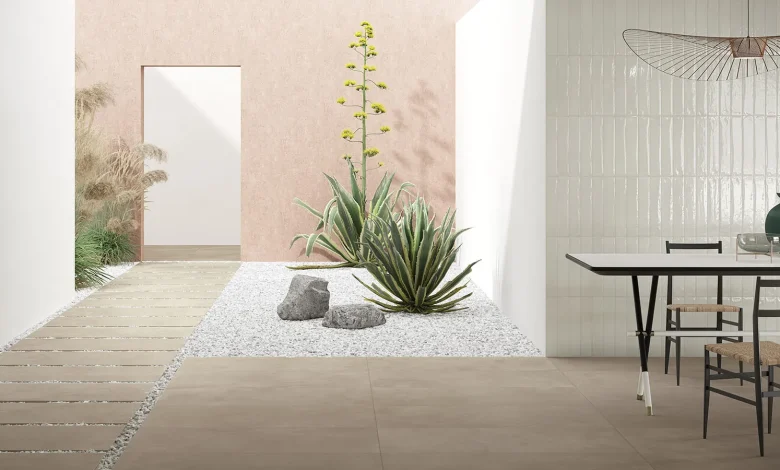Indoor vs. Outdoor Tiles: What’s the Difference?

Introduction
Tiles are a versatile and durable choice for enhancing both indoor and outdoor spaces, but not all tiles are created equal. The differences between indoor and outdoor tiles are significant, impacting their performance, safety, and aesthetic appeal. Indoor tiles are designed for style and moderate use, while outdoor tiles must withstand harsh weather, heavy traffic, and environmental challenges. This comprehensive guide explores the key distinctions between indoor and outdoor tiles, covering durability, materials, slip resistance, design, installation, and maintenance. Whether you’re tiling a cozy kitchen or a sprawling patio, understanding these differences will help you choose the right tiles for your project.
Key Differences Between Indoor and Outdoor Tiles
Durability and Material Composition
Durability is a primary differentiator between indoor and outdoor tiles. Outdoor tiles face extreme conditions—rain, snow, UV exposure, and temperature fluctuations—requiring superior strength. The Porcelain Enamel Institute (PEI) rating measures a tile’s resistance to abrasion, with ratings from 0 to 5. Outdoor tiles typically have PEI 4 or 5 ratings, suitable for heavy commercial or residential outdoor use, while indoor tiles may have PEI 1–3 for lighter traffic areas like bedrooms or kitchens (PEI Rating Guide).
Outdoor tiles are often thicker to enhance durability. Standard indoor porcelain tiles are about 1/4 inch thick, while outdoor porcelain pavers can reach 3/4 inch (2cm), providing stability for heavy loads like furniture or vehicles (Daltile Outdoor Tile Guide). Common outdoor materials include porcelain and natural stone (e.g., slate, granite), which are denser and more resilient than ceramic, often used indoors.
Water Resistance
Water resistance is critical for outdoor tiles, as moisture can cause cracking or staining. Porcelain tiles, with a water absorption rate of less than 0.5%, are ideal for outdoor use due to their density, preventing water penetration even in freeze-thaw cycles (Tile Specs Glossary). Ceramic tiles, with higher absorption rates (up to 7% for non-vitreous types), are better suited for indoor areas like bathrooms or kitchens where moisture is controlled (Ceramic Tile Quality).
In regions with cold winters, low water absorption is essential to prevent tiles from cracking when water freezes and expands. Always check manufacturer specifications for water absorption rates when selecting outdoor tiles.
Slip Resistance
Safety is a top concern for outdoor tiles, especially in wet areas like pool decks or entryways. Slip resistance is measured by the Dynamic Coefficient of Friction (DCOF), with a minimum of 0.42 recommended for outdoor surfaces to reduce fall risks (Porcelain Tile Grades). Textured or matte finishes enhance slip resistance, making them preferable for outdoor use, while glossy finishes are common indoors for aesthetic appeal (External Tiling and Slip Resistance).
Indoor tiles may prioritize style over safety, with smoother surfaces suitable for low-moisture areas. For outdoor projects, always verify the DCOF rating to ensure compliance with safety standards.
Design and Aesthetics
Indoor tiles offer a wide range of designs, colors, and patterns, catering to diverse interior styles. From vibrant mosaics to sleek marble-look ceramics, indoor tiles prioritize aesthetic versatility (Australian Paving Centre). Outdoor tiles, while also varied, often feature natural finishes like stone, wood, or concrete to blend with exterior environments (Emser Tile Blog).
Large-format tiles (e.g., 24×24 inches) are popular outdoors for a seamless look with fewer grout lines, reducing maintenance. Smaller tiles or mosaics add decorative flair to pool surrounds or pathways. Current trends favor wood-look porcelain for outdoor patios and neutral-toned natural stone for timeless elegance (Homes and Gardens).
Installation Requirements
Installation methods differ significantly between indoor and outdoor tiles. Outdoor tiles require robust substrates, such as concrete slabs, to ensure stability under varying conditions. In some cases, 2cm porcelain pavers can be installed on sand or gravel beds, offering cost savings over concrete bases (Lucretia Tiles). Movement joints are essential outdoors to accommodate ground shifts, preventing cracking (Tile.co.uk Outdoor Guide).
Indoor tiles can be installed on simpler substrates like plywood or existing floors, with less concern for weather-related movement. Proper installation, including weather-resistant adhesives and sealants, is critical for outdoor tiles to ensure longevity.
Types of Outdoor Tiles
Outdoor tiles come in various materials, each suited to specific applications. Below is a detailed overview of the most common types.
Porcelain Tiles
Porcelain tiles are a top choice for outdoor use due to their durability, low water absorption, and design versatility. Fired at high temperatures, porcelain is dense and resistant to weathering, fading, and staining. Thicker 2cm porcelain pavers are ideal for patios, walkways, or driveways, supporting heavy loads (Stiled.com).
-
Pros: Long-lasting, low maintenance, wide design range, frost-resistant.
-
Cons: Higher cost, can be cold underfoot.
Natural Stone Tiles
Natural stone tiles, such as slate, granite, limestone, and travertine, offer unique aesthetics and durability. Each type has distinct properties:
-
Slate: Naturally slip-resistant, available in colors like gray, purple, or green, ideal for patios (The Spruce).
-
Granite: Extremely hard, suitable for high-traffic areas, resists weather extremes.
-
Limestone: Rustic charm, requires sealing, best for mild climates.
-
Travertine: Pitted texture, needs sealing, suited for temperate regions.
-
Pros: Elegant, unique, property value-enhancing.
-
Cons: High maintenance, can be slippery if unsealed.
Ceramic Tiles
While less common outdoors, high-quality ceramic tiles can be used in covered areas. They are affordable but have higher water absorption, making them less durable in harsh conditions.
-
Pros: Cost-effective, design variety, easy to install.
-
Cons: Prone to cracking, not ideal for heavy traffic.
Other Types
-
Concrete Tiles: Durable, mimic stone or wood, suitable for modern designs (BuildDirect).
-
Glass Tiles: Decorative for pool mosaics, not for flooring due to fragility (Architessa).
-
Mosaic Tiles: Add patterns, vary in durability based on material.
|
Tile Type |
Durability (PEI) |
Water Absorption |
Slip Resistance (DCOF) |
Best Use |
|---|---|---|---|---|
|
Porcelain |
4–5 | <0.5% | ≥0.42 |
Patios, walkways |
|
Slate |
3–4 | 0.1–0.5% | ≥0.42 |
Patios, paths |
|
Granite |
4–5 | <0.5% | ≥0.42 |
High-traffic areas |
|
Limestone |
3 | 1–3% |
Varies |
Covered patios |
|
Ceramic |
2–3 | 3–7% |
Varies |
Covered areas |
Choosing the Right Tiles for Your Outdoor Space
Selecting the right tiles involves balancing functionality, aesthetics, and budget. Consider these factors:
-
Climate: In cold regions, choose frost-resistant tiles with low water absorption to prevent cracking. In hot climates, UV-resistant tiles prevent fading.
-
Traffic: High-traffic areas need PEI 4–5 tiles; low-traffic areas can use decorative options.
-
Aesthetics: Match outdoor tiles to indoor ones for a cohesive look, or choose contrasting designs for vibrant outdoor spaces (Oasis Tile).
-
Maintenance: Porcelain requires minimal upkeep, while natural stone needs regular sealing.
-
Budget: Porcelain and ceramic are cost-effective; natural stone is pricier but adds value.
Visiting a showroom allows you to see tiles in person and consult experts. For those in Toronto, the Best Tile Store in Toronto offers a vast selection of indoor and outdoor tiles, with knowledgeable staff to guide your choices.
Maintenance and Care for Outdoor Tiles
Proper maintenance extends the life of outdoor tiles. Here’s how to care for different types:
-
Porcelain: Sweep regularly, clean with mild detergent and water. Avoid acidic cleaners to protect the glaze.
-
Natural Stone: Seal every 1–2 years to prevent staining. Use pH-neutral cleaners. For travertine, fill pits with consolidators (Clé Tile).
-
Ceramic: Sweep and mop with mild cleaner. Seal grout to prevent staining.
General tips:
-
Remove stains quickly to avoid setting.
-
Use soft brushes to prevent scratches.
-
Treat moss or algae with tile-safe solutions.
-
Inspect for cracks post-weather events.
Conclusion
The differences between indoor and outdoor tiles are rooted in their ability to meet distinct environmental demands. Outdoor tiles prioritize durability, water resistance, and slip resistance, using materials like porcelain and natural stone to withstand weather and traffic. Indoor tiles focus on aesthetic versatility, suitable for controlled environments. By understanding these distinctions and considering climate, traffic, and design goals, you can select tiles that enhance your home’s functionality and beauty.
For your next project, explore options at a trusted tile retailer. In Toronto, the Best Tile Store in Toronto provides an extensive range of tiles and expert advice to ensure your indoor and outdoor spaces shine. Choose wisely, and enjoy durable, stunning tiled surfaces for years to come.






